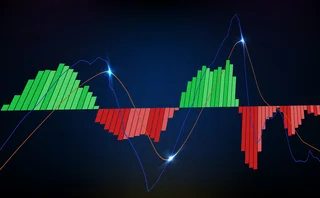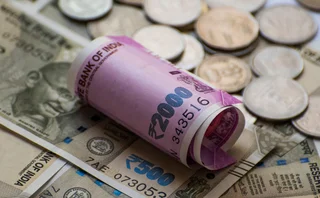
Negative repos distort dividend hedging strategies
Abnormally low repurchase rates are forcing banks to hedge their dividend exposures with swaps instead of forwards.
Long-term implied repo rates on the Dow Jones Eurostoxx 50 and Nikkei 225 indexes have been driven to distressed levels, which some dealers say has forced them to avoid buying forwards to hedge dividend exposures. Instead, banks are hedging dividend exposure through the dividend swap market, while warehousing the repo risk.
Repos dived into negative territory as dealers rushed to hedge short forward exposures after equity markets plunged in the first quarter of this year. Implied repo rates are one of three functions used in pricing forwards, the other two being dividends and the risk-free interest rate.
Dealers are inherently short forwards as a result of selling structured products such as auto-callables and reverse convertibles. These products usually redeem at par and pay a high coupon, so long as the reference stock does not fall below a pre-defined barrier. If the stock price does fall below this level, the note would redeem in shares.
In buying the note, the investor implicitly sells a put option that knocks in once the underlying price falls below the barrier. Dealers are therefore long the put option, which creates a long dividend position and hence a short forward exposure.
Dealers became increasingly short forwards as underlying index prices dropped and were forced to hedge their expanding exposures. "As the market tanked, there ensued a frenzy of long-dated forwards buying by exotics desks," said Bertrand Delarue, Paris-based global head of product engineering at BNP Paribas. "This pushed repo rates deep into negative territory and created a dislocation in the forwards market. Since dividend prices could be observed from the dividend swap market, the prices of the forwards, by way of repos, became more expensive."
On June 25 last year, the December 2014 implied repo on the Dow Jones Eurostoxx 50 index traded at 8 basis points, while the dividend yield was 402bp, leaving a real yield of 410bp, according to Société Générale Corporate and Investment Banking (SG CIB). By June 2 this year, the repo had been pushed down to -78bp, while the dividend yield was trading at 303bp, giving a real yield of 226bp. The repo traded at -50bp on June 24.
Meanwhile, the December 2014 implied repo on the Nikkei 225 index was priced at -6bp on June 25, 2008, while the dividend yield was at 158bp, giving a real yield of 152bp. The repo had collapsed to -130bp by February 9 this year, with the dividend yield at 97bp, giving a real yield of -33bp. The repo priced at -78bp on June 24.
"Repos became extremely distressed," said Arié Boleslawski, head of exotic trading, equity derivatives, at SG CIB. "Dealers who tried to hedge dividend risk on the Eurostoxx 50 index would find that almost 15% of the dividend yield was being wiped out by the negative repo. On the Nikkei, it was even worse - repos dived way below -100bp, which effectively meant negative dividends."
The resulting dislocation of the forwards market has meant dealers have been using the dividend swap market to hedge dividend exposure and housing the repo risk, rather than buying forwards. "Dealers used to use forwards to sell the dividends and hedge the repo at the same time," says SG CIB's Boleslawski. "But because they are so expensive, some of them are now hedging their dividend exposures using dividend swaps and keeping the repo risk on the books."
The dividend swap market rallied sharply in the second quarter this year, reflecting growing confidence about the future of the equity market and the recovery of equity prices. On September 15 last year (the day Lehman Brothers filed for bankruptcy), December 2010 Dow Jones Eurostoxx 50 implied dividends (derived from the prices of dividend swaps) traded at 134.4 points, only to decline over the next six months to a low of 54 on March 10, according to Barclays Capital. It had climbed to 83.1 on July 2 - a rise of 53% from the mid-March lows. Similarly, 2011 implied dividends fell from 134.5 on September 15 to 51.7 on March 10. They had rallied to 76.3 by July 2. Equity markets also rallied around the world: the Eurostoxx 50 went from 2071.13 on March 31 to 2401.69 on June 30, and the Nikkei 225 rose from 8109.53 to 9958.44 over the same period.
Although banks are housing more repo exposure on their books, dealers claim the risk presents few problems. "These are mark-to-market trades. It is not like being short gamma and having to realise a loss when volatility hikes. The negative repo is just a mark-to-market of your forward and if you roll your futures position every day, this loss will become a gain in carry," says BNP Paribas's Delarue.
See also: Selling pressure lifts on dividends
Gambling on dividends
Only users who have a paid subscription or are part of a corporate subscription are able to print or copy content.
To access these options, along with all other subscription benefits, please contact info@risk.net or view our subscription options here: http://subscriptions.risk.net/subscribe
You are currently unable to print this content. Please contact info@risk.net to find out more.
You are currently unable to copy this content. Please contact info@risk.net to find out more.
Copyright Infopro Digital Limited. All rights reserved.
As outlined in our terms and conditions, https://www.infopro-digital.com/terms-and-conditions/subscriptions/ (point 2.4), printing is limited to a single copy.
If you would like to purchase additional rights please email info@risk.net
Copyright Infopro Digital Limited. All rights reserved.
You may share this content using our article tools. As outlined in our terms and conditions, https://www.infopro-digital.com/terms-and-conditions/subscriptions/ (clause 2.4), an Authorised User may only make one copy of the materials for their own personal use. You must also comply with the restrictions in clause 2.5.
If you would like to purchase additional rights please email info@risk.net
More on Equity markets
The future of equity derivatives: perspectives for UK equities and dividends
Managing equity and dividend risk today requires new trading strategies and products. In a webinar convened by Risk.net and hosted by Eurex, three experts discuss what’s next for the UK and European markets.
Follow the moneyness
Barclays quants extend Bergomi’s skew stickiness ratio to all strikes
What gold's rise means for rates, equities
It has been several years since we have seen volatility in gold. An increase in gold volatility can typically be associated with a change in sentiment and investor behavior. The precious metal has surged this year on increased demand for safe haven…
Breaking the collateral silos – Navigating regulation with a strategic alternative
Emmanuel Denis, head of tri‑party services at BNP Paribas Securities Services, discusses why financial institutions must rethink old practices of collateral management and instead adopt a tri-party approach, with which equities can be managed as…
BAML and Morgan Stanley shift Indian P-notes to Europe
Tax changes trigger move out of Mauritius and Singapore
Volatility traders wrestle with digital risk of Brexit
Skew on major indexes leaps after market wakes up to risks of UK's referendum
New US tax rules could hamper ETN market, dealers warn
IRS’s forthcoming Section 871(m) rules could inadvertently capture legacy ETNs
Dealers fear death of dividend risk premia strategy
Shrinking dividend futures premium hurting investors







